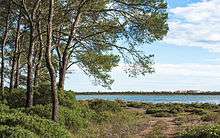Salicornia europaea
| Salicornia europaea | |
|---|---|
| | |
| Scientific classification | |
| Kingdom: | Plantae |
| (unranked): | Angiosperms |
| Class: | Eudicots |
| Order: | Caryophyllales |
| Family: | Amaranthaceae |
| Genus: | Salicornia |
| Species: | S. europaea |
| Binomial name | |
| Salicornia europaea L. | |
| Synonyms[1] | |
| |

Salicornia europaea , known as common glasswort[2] or just glasswort, is a halophytic annual dicot which grows in various zones of intertidal salt marshes. The ashes of glasswort and saltwort plants and of kelp were long used as a source of soda ash (mainly sodium carbonate) for glassmaking and soapmaking. The introduction of the LeBlanc process for the industrial production of soda ash superseded the use of plant sources in the first half of the 19th century.
Culinary use
Salicornia europaea is edible, either cooked or raw.[3] In England, it is one of several plants known as samphire (see also rock samphire); the term samphire is believed to be a corruption of the French name, herbe de Saint-Pierre, which means "St. Peter's herb".[4]
Samphire is usually cooked, either steamed or microwaved, and then coated in butter or olive oil. Due to its high salt content, it must be cooked without any salt added, in plenty of water. It has a hard, stringy core, and after cooking, the edible flesh is pulled off from the core. This flesh, after cooking, resembles seaweed in colour, and the flavour and texture are like young spinach stems or asparagus. Samphire is often used as a suitably maritime accompaniment to fish or seafood.
References
- ↑ "Salicornia europaea L.". World Checklist of Selected Plant Families (WCSP). Royal Botanic Gardens, Kew. Retrieved 21 October 2015 – via The Plant List.
- ↑ "BSBI List 2007" (xls). Botanical Society of Britain and Ireland. Retrieved 2014-10-17.
- ↑ "Salicornia", page of the Plants for a Future website. Retrieved July 14, 2007.
- ↑ Davidson, Alan (2002). The Penguin Companion To Food (Penguin), p. 828. ISBN 978-0-14-200163-9. On Food and Cooking: The Science and Lore of the Kitchen, Completely Revised and Updated (Scribner, New York), p. 317. ISBN 978-0-684-80001-1.
|